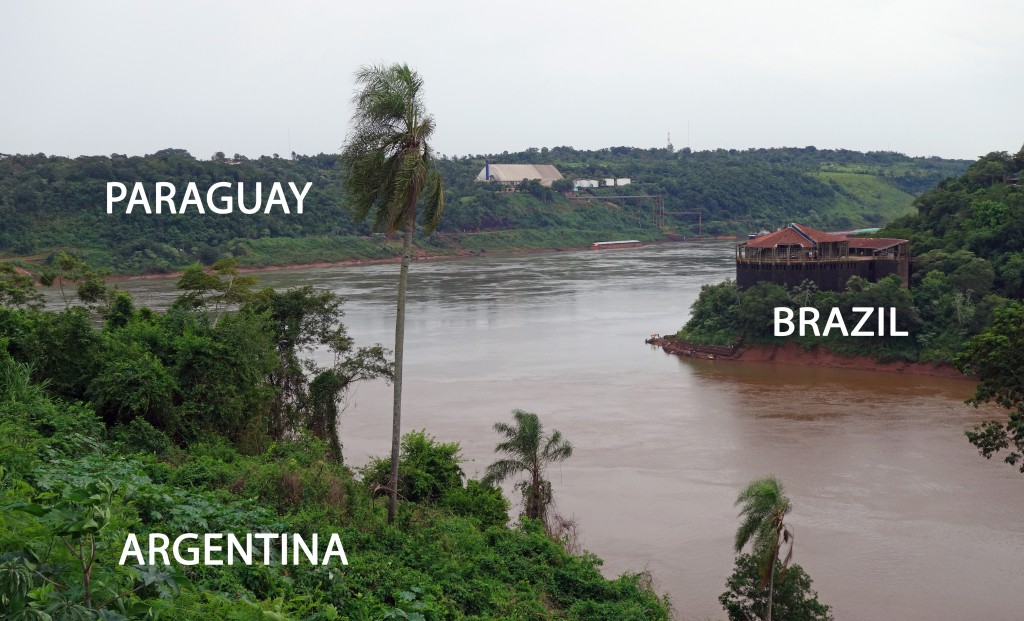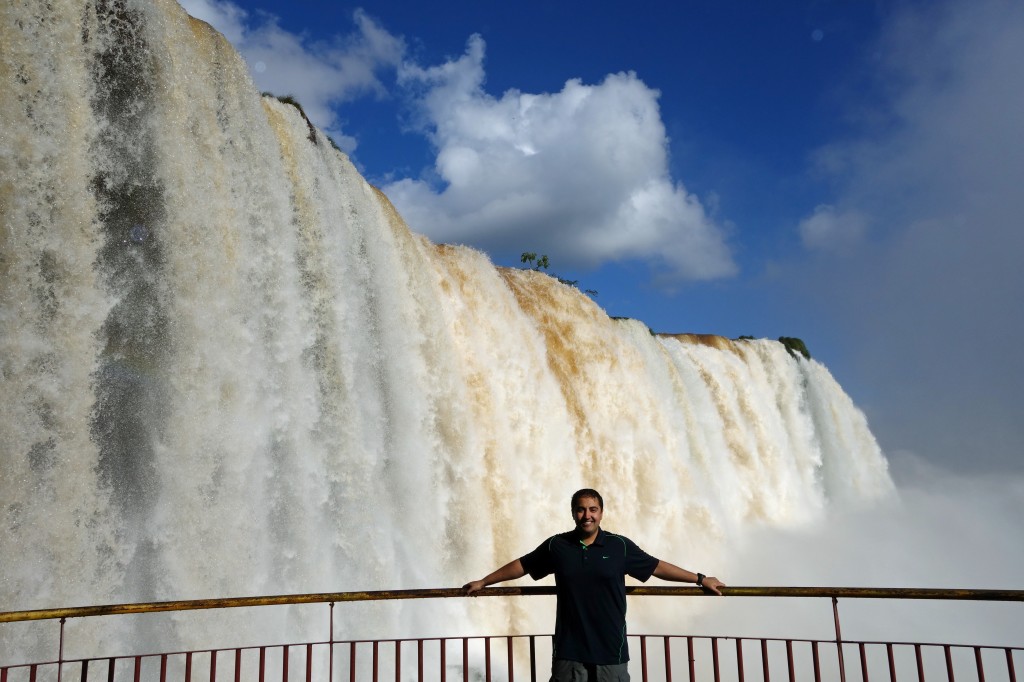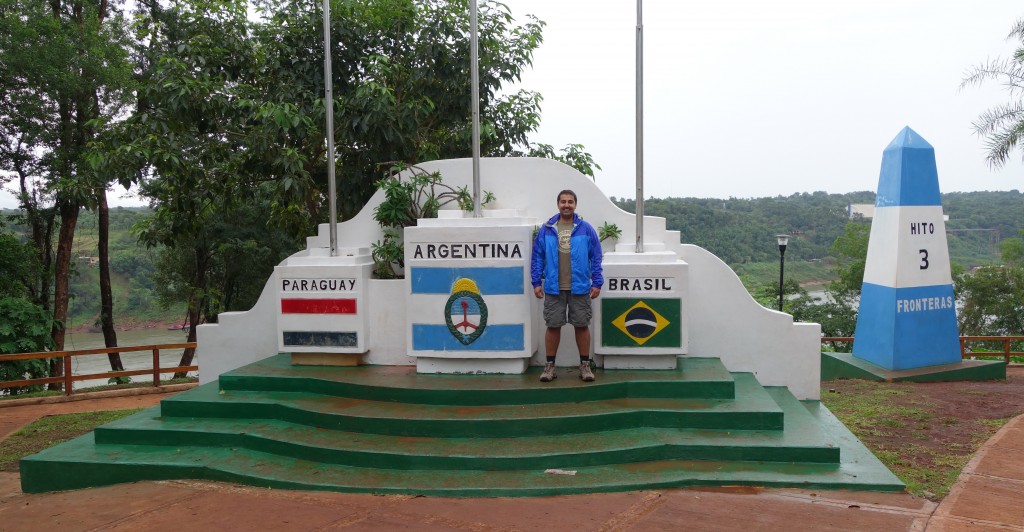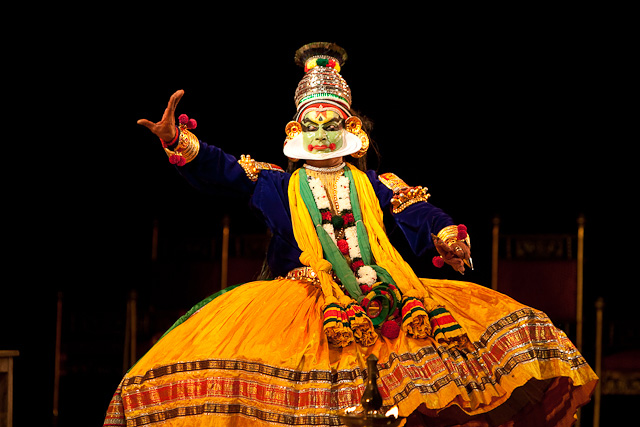Dazed and Confused in Iguazu

The town of Puerto Iguazu sits atop the Northeastern tip of Argentina on an upwards crooking appendage of land that cusps the bottom of Paraguay and terminates where the Rio Iguaçu runs into the Paraná River at ninety degrees. This T-junction of rivers marks the border between three nations, Argentina, Brazil and Paraguay.
I came here to see Iguazu Falls, one of the world’s most impressive waterfalls (truly!), but became marooned in this sleepy, not-much-going-on town because I needed a visa to proceed into Brazil, and the consulate had shut down for a four day long Easter break just as I arrived. I wound up spending nine nights in Iguazu when most travelers make do with two or three. I passed much of the time reading books I’d found at book exchanges in some of Iguazu’s hostels and cafes, or walking along the lush green and densely forested river bank of the Rio Iguaçu.
On one such late afternoon walk to the Tres Fronteras (triple border), my ears picked up an unusual sound amid the chirping of many colorful birds and the background noise of the river. I doubted it initially but as I drew nearer, I became certain I was hearing drums. Energetic drums, a charged beat heralding the performance of a holy ritual. Out of sight, a hundred meters of jungle away, men with painted masks and swirling skirts were narrating an ancient epic through dance. A Kathakali performance was underway. Odd, since this is a Hindu art form originating from Kerala (South India) and I’m in South America. Yet strangely, I was fine with this incoherence.
Further down the road I passed a dark skinny man with white hair and a white bushy mustache. He was bent under the weight of the gunny bag he was carrying on his back, which was bursting with tamarind pods. The sharp smell of tamarind reminded me of my childhood in Karachi, climbing the tamarind tree in my great grandfather’s front yard with my cousins and eating so much tamarind that our tummies hurt. But Tamarind is not native to North Argentina. Oh well. I could now see the T-junction of rivers up ahead. Next to me, the Rio Iguaçu was moving urgently, strong ropey currents strangling each other on their way downstream. Over the river, the faint sounds of a song were carrying to my ears and steadily growing louder.
Enda da korangacha, chandi ithra thenjadu?
(Hey Mr. monkey man, why’s your bum so red?)
Pandyill thooran poyappol nerakkamuthiri nerangi njan.
(I went for a shit to Madras, and scraped it till it bled.)
Two identical rowboats came into view, each manned by two shirtless men, a tangled pile of fishing net bulging over the stern giving away the profession of the spirited quartet on board. Leaving aside the ridiculousness of the song (who travels to a different city to take a shit?), why were these fishermen singing in Malayalam, the language of Kerala? Spanish is the language of Argentina and Paraguay, and Brazilians speak Portuguese.

The Rio Iguaçu running into the Paraná River, the border area between Argentina, Brazil and Paraguay.
Up ahead a dozen children were playing cricket on the street, screaming and squealing with each ball, each run, no matter how ordinary. The score didn’t matter. The joy was in the novelty and amusement of the company, not the game. Perhaps cousins seeing each other after a long time, or for the first time. As I got closer, I spied the house to which the children belonged. Three banana trees stood in the front yard, fenced off by panels of woven palm leaves. A solemn young bride sat framed in the doorway of the house. A wedding! She was surrounded by much larger fisherwomen relatives who were braiding her hair. She was sobbing. They were singing. “Pandoru mukkuvan muthinu poyi” (Once a fisherman went out to sea) it started. It was a sad song sung to girls in preparation for weddings to men they didn’t love. The familial sorrowfulness had the slowing down effect of quicksand. The relatives moved about the gently sobbing bride so lazily that not even a ripple broke the surface of their large, round out-of-sari midriff fat bulges that are typically prone to excessive jiggliness. How is this South America? Nothing is right with this picture.
It was almost 4 o’clock, end of siesta time in Argentina. An old man with smudged sandalwood paste on his forehead woke from his charpoi and staggered to the stove to warm his peppered coconut milk. Kerala again. What is going on? Everything is wrong, and it’s my fault. Worlds have been mixed.
You see, I left for this walk immediately after finishing reading The God of Small Things under a tree by the river. Set in Kerala, it is one of the most beautiful novels I’ve read in a long time (and winner of the 1997 Booker Prize). So while my physical journey had brought me to Iguazu, my imagination had caught a train to Kerala, a similarly lush green and densely forested place, but along another river on a different continent. Two halfs of me had been traveling simultaneously but separately, and now found themselves oceans apart.
And I continue to travel this way because I can cover twice the distance in the same amount of time. One half of me travels on metal contraptions that fly through the heavens, float across seas, and roll over the highways and byways of our physical world, while the other half travels on the yellowing pages of warped and coffee stained books found at the back of hostels and cafes that further stoke an already blazing fire of wanderlust.



Recent Comments